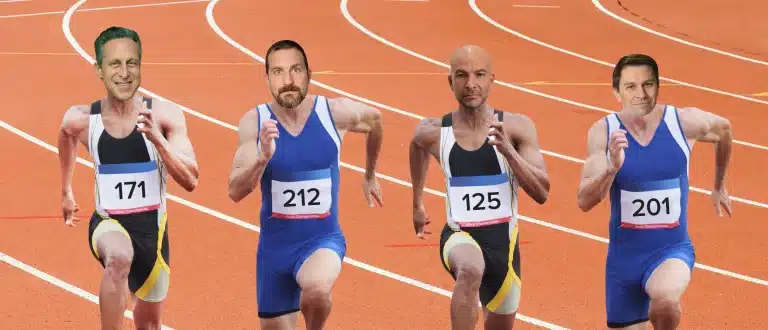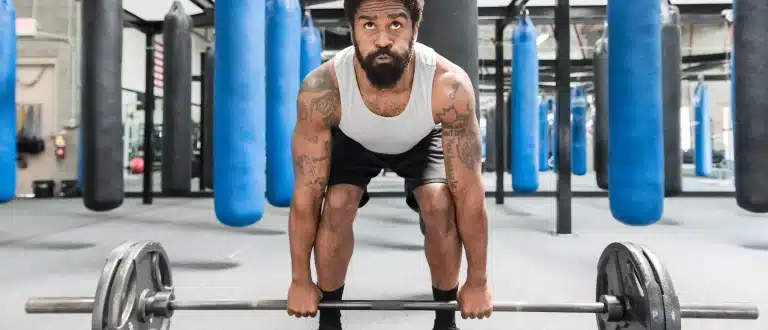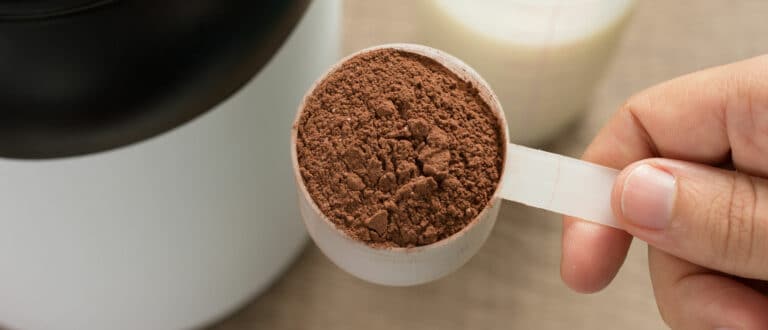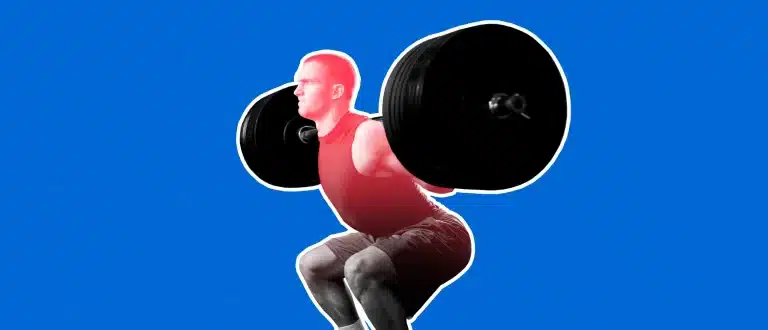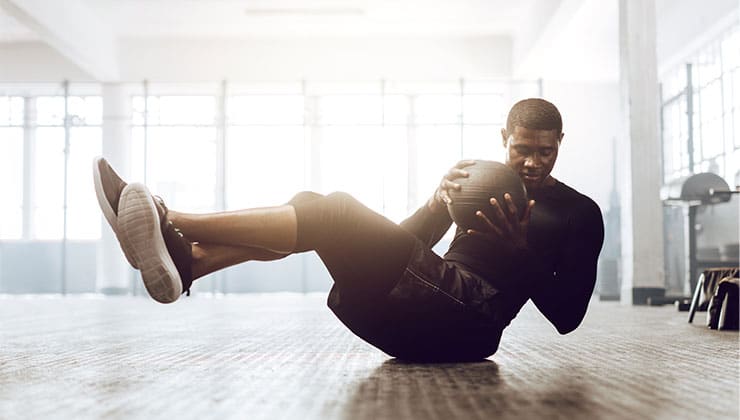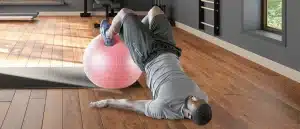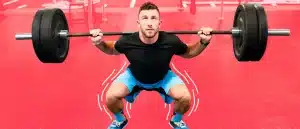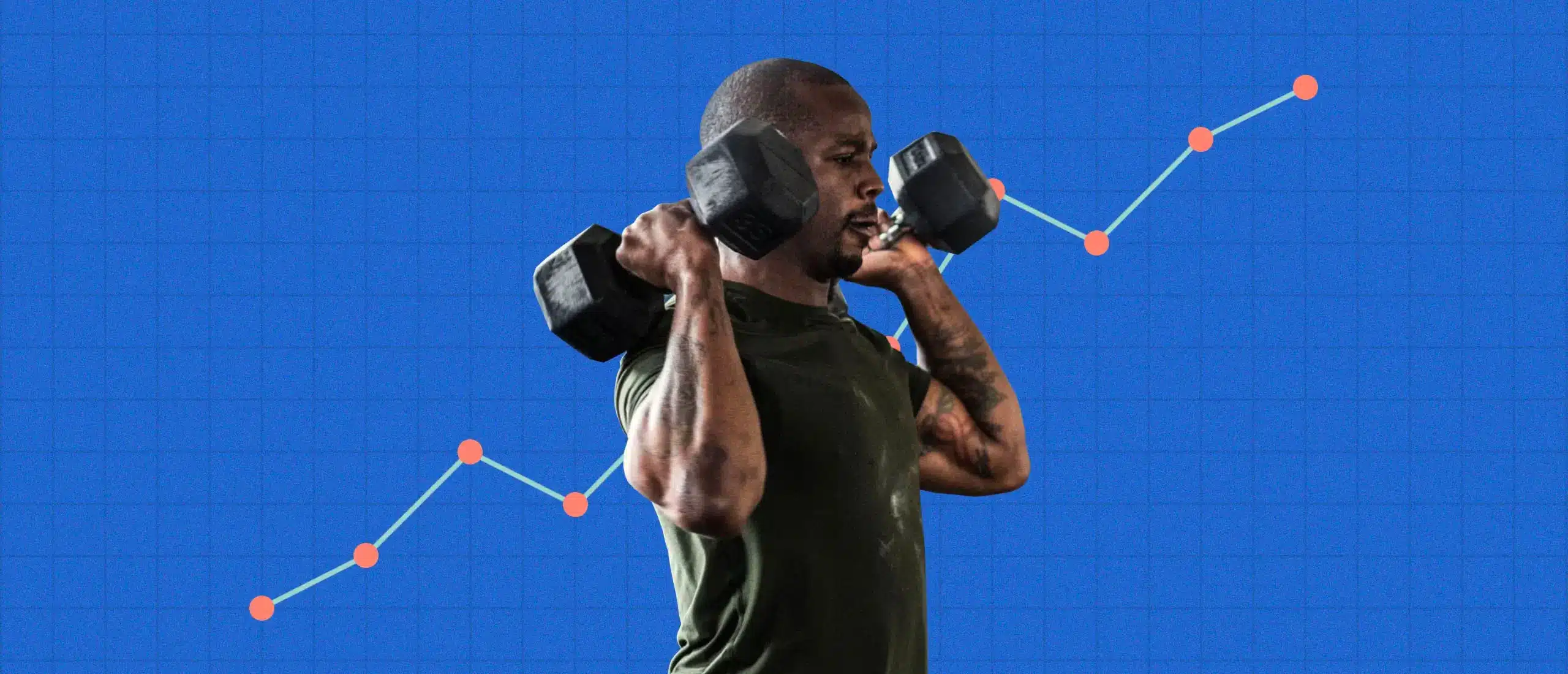
Does Working Out Increase Testosterone Levels?
- By Sydney Bueckert, NASM C.P.T., C.E.S., F.N.S., G.P.T.S.
- Medically reviewed by M.D. jack jeng
- August 21, 2023
Fast Facts
- Men who exercise regularly have higher testosterone levels than those who are physically inactive.
- Heavy strength training and HIIT are the best workouts for a testosterone boost.
- Physical activity immediately boosts testosterone, and might contribute to long-term lifts in T, too.
Feeling lousy? Low testosterone might be the culprit. Around the age of 30, men’s T levels start to drop by about one percent per year (1). A dip in energy, low sex drive, and unexpected weight gain are just a few of the signs you might be running low.
Replenishing your T levels is vital to living life at your full potential, and exercise can help. But not all exercise is equal when it comes to increasing testosterone. Here’s everything you need to know about how your workouts affect testosterone levels.
Does Working Out Increase Testosterone?
In short, yes. One study found that men who exercised regularly had remarkably higher testosterone levels than men who didn’t (2). Regular exercise works to boost total T in a few ways.
It Promotes Weight Loss and Maintenance
Higher overall body weight and obesity is directly linked to lower testosterone levels (3). According to a study published in Clinical Endocrinology, obese men between the ages of 14 and 20 have up to 50 percent less testosterone than their peers (4). By keeping your weight in check, you can typically expect more normal levels of T.
But you don’t have to wait for a change in body mass for exercise to make a positive impact. One study following obese men found that regular exercise increased T levels more than actually losing weight (5).
It Stimulates Muscle Growth
By strength training, you can build and maintain muscle mass. Studies have shown the more muscle worked during your workout, the greater your testosterone response after your workout (6).
Think of strength training and testosterone as a feedback loop. When you strength train, you build muscle. When you have more muscle, you can recruit more muscle fibers during your workout. More muscle targeted, means a higher boost in T. Since testosterone is an anabolic hormone (a hormone that builds muscle), more T helps you build and retain muscle.
However, while a workout can boost your immediate testosterone response, it doesn’t necessarily mean you’ll have higher levels of resting testosterone. It’s essential that you’re doing the right things to properly stimulate your muscles.
The Best Exercises to Increase Testosterone
Some types of exercise are better than others when it comes to increasing testosterone. Research has shown exercise that involves more muscle groups, at moderate to high intensity, with short rest intervals is the most optimal way to increase testosterone production (3).
That means if you want to boost T, it’s time to make resistance training and high-intensity interval training (HIIT) your best friends. Here’s how it works.
Resistance Training
Pump up the heavyweights. Weight lifting—specifically heavy strength training—has been shown to boost your T levels immediately after your workout and over time (3).
There are four crucial factors for optimizing your testosterone response from a workout:
- Hit multiple muscle groups
- Lift heavy
- Keep volume high (reps and sets)
- Cut rest time
Let’s dive deeper into each.
Choose Compound Exercises
Maximizing your muscle mass used during a session is the key to increasing T. One study found exercising small amounts of mass by doing isolation exercises like bicep curls does not elevate testosterone over resting levels (7).
Add in compound exercise—exercises that use multiple large muscle groups—like squats, deadlifts, bench press, or rows and you might see a welcome boost in T.
Focus on training with free weights like dumbbells or barbells in place of machines. One small study found that men who trained with free weights experienced a higher T response than those who trained with machines (8). Free weights offer a more unstable training environment which enhances muscle recruitment during your workout.
Lift Heavy
When you lift heavy, your central nervous system (CNS) responds, transmitting electrical signals from your brain to your muscles. The heavier the load, the more muscle fibers your CNS recruits in response (and remember more muscle involvement equals more T).
One study found that circulating total testosterone increases in men immediately after a bout of heavy resistance exercise (9). So load up.
Reps, Sets, and Rest Matter
Cut the scrolling and amp up the workload. How you pair your heavy lifts with training volume and rest impacts T, too.
A review of current research concluded that resistance workouts that are moderate to high in intensity, high in volume, use short rest intervals, and target more muscles tend to produce the greatest elevation in testosterone, particularly when compared to high-intensity exercise performed at a low volume with long rest breaks (3).
Another study found that pairing moderate intensity strength training with higher volume and shorter resting periods led to significant gains in post-exercise total testosterone (10). Plus, the T stayed elevated for 48 hours after exercise.
HIIT
If you love HIIT training, you’re in luck. A load of evidence suggests T levels climb when guys add HIIT to their workout routines (11).
The key is in the intensity. One study found that moderate to high-intensity exercise led to significant increases in total T, but low-intensity exercise did not (12).
Another study followed 30 men aged 30 to 45, and found men who participated in three sessions a week of one hour of high-intensity intervals and strength training resulted in a whopping 36.7-percent increase in testosterone (13).
Walking
If you’re after easier ways to boost T, a recent study found that increasing your step count might make a difference. The study discovered that men with higher daily step counts (above 4,000) had elevated testosterone levels and a lower risk of hypogonadism (when T levels decrease below 300 ng/dL) in comparison to guys who got less than 4,000 steps per day (14).
Interestingly, the study also found that for every additional 1,000 steps you take daily, total testosterone increases by 7 ng/dL. That could be a significant lift for someone with low T.
Does Working Out Immediately Boost T?
Yep. Your testosterone levels rise immediately after your workout. The real debate is how long the elevation lasts. Most studies have found this increase typically lasts anywhere from 20 to 90 minutes (15, 16). There are outliers though. One study found the effects to last up to 48 hours (10).
Does Regular Exercise Boost T, Long Term?
The anecdotal effects of exercise on prolonged elevation in T levels have long been claimed, but until recently, evidence was limited. Now, new research is breaking ground.
A study published in Steroids followed a group of 40 men aged 21 to 40 (17). After intensive exercise, middle-aged men experienced an increase in resting testosterone levels. Interestingly, high-intensity exercise also reduced the natural age-related drop in T, too.
What is the Best Time to Workout to Boost T?
The best time to work out to boost testosterone is in the afternoon. This is interesting because testosterone and cortisol levels naturally peak in the morning.
Testosterone has an anabolic effect on muscles—it can help your muscles recover and grow—but cortisol is catabolic: it breaks down muscles. Plus, cortisol counteracts testosterone production.
This means testosterone has to compete with cortisol when you work out in the morning.
In the afternoon, both testosterone and cortisol are low. Experts believe that since cortisol is low, the testosterone released in response to exercise is more effective. One study found that when you strength train in the afternoon, it induces a more favorable boost in T (18).
This unique balance of cortisol and testosterone in the afternoon is better for HIIT, too. Another study found that afternoon HIIT boosted testosterone and produced a more favorable anabolic response than when the same bout of HIIT was completed in the morning (19).
Can Exercise Decrease Testosterone?
Generally, working out boosts testosterone. However, when you workout too much, it can lead to an increase in cortisol levels (your body’s stress hormone) and a decrease in testosterone (15, 20).
When your body is overtaxed by an imbalance in cortisol, you may experience chronic fatigue, muscle fatigue, changes in mood, and a decrease in heart rate variability (an important indicator of how your body is capable of dealing with stress and performing).
To keep your testosterone levels afloat, it’s important to avoid overtraining. Next time you challenge yourself with a HIIT workout, endurance exercise, or heavy lift, be sure to plan for rest afterward to reap the biggest gain.
How TRT Can Help When Exercise Isn’t Enough
If you’ve been working out consistently and not seeing any gains, you might have low T. While exercise can help to boost T, it’s just one piece of the puzzle. There are many other ways to naturally boost testosterone like eating more protein, minimizing stress, and getting more sleep.
Sometimes, lifestyle changes aren’t enough, that’s where medical treatment can help. If you’ve been suffering from the symptoms of low T and haven’t tested your T levels yet, Hone can help with that.
Testosterone replacement therapy (TRT) is available to men low in T. TRT can give you the benefits of regular testosterone levels including elevated energy, mental health, libido, and weight loss so you can get back to being you.
Hone’s at-home testosterone assessment is the simplest way to uncover whether your levels are low. If you qualify for treatment, TRT can be sent right to your door.
The Bottom Line
Men who are generally more active typically have higher levels of testosterone. Heavy strength training and HIIT are the best workouts to boost testosterone, but even simply getting more active (like increasing your step count) can help.
References
1. Travison, T. et al (2007). A Population-Level Decline in Serum Testosterone Levels in American Men.
2. Yeap, B. et al (2020). Sociodemographic, Lifestyle, and Medical Influences on Serum Testosterone and Sex Hormone-Binding Globulin in Men From UK Biobank.
3. Riachy, R. et al (2020). Various Factors May Modulate the Effect of Exercise on Testosterone Levels in Men.
4. Mogri, M. et al (2012). Testosterone Concentrations in Young Pubertal and Post-Pubertal Obese Males.
5. Kumagai, H. et al (2016). Increased Physical Activity Has a Greater Effect Than Reduced Energy Intake on Lifestyle Modification-Induced Increases in Testosterone.
6. Vingren, J. et al (2010). Testosterone Physiology in Resistance Exercise and Training: The Up-Stream Regulatory Elements.
7. Migiano, M. et al (2010). Endocrine Response Patterns to Acute Unilateral and Bilateral Resistance Exercise in Men.
8. Schwanbeck, S. et al (2020). Effects of Training With Free Weights Versus Machines on Muscle Mass, Strength, Free Testosterone, and Free Cortisol Levels.
9. Kvorning, T. et al (2007). Suppression of Testosterone Does Not Blunt mRNA Expression of MoyD, Myogenin, IGF, Myostatin or Androgen receptor Post Strength Training in Humans.
10. McCaulley, G. et al (2008). Acute Hormonal and Neuromuscular Responses to Hypertrophy, Strength and Power Type Resistance Exercise.
11. Velasco-Orjuela, G. et al (2018). Acute Effects of High-Intensity Interval, Resistance or Combined Exercise Protocols on Testosterone—Cortisol Responses in Inactive and Overweight Individuals.
12. D’Andrea, S. et al (2020). Endogenous Transient Doping: Physical Exercise Acutely Increases Testosterone Levels—Results From a Meta-Analysis.
13. Ambrozy, T. et al (2021). The Effect of High-Intensity Interval Training Period on Morning Serum Testosterone and Cortisol Levels and Physical Fitness in Men Aged 35-40 Years.
14. Giudice, F. et al (2021). Associations of Daily Step Count and Serum Testosterone Among Men in the United States.
15.Daly, E. et al (2005). Relationship Between Stress Hormones and Testosterone with Prolonged Endurance Exercise.
16. Maresh, C. et al (2006). Effect of Hydration State on Testosterone and Cortisol Responses to Training-Intensity Exercise in Collegiate Runners.
17. Sellami, M. et al (2018). The Effect of Acute and Chronic Exercise on Steroid Hormone Fluctuations in Young and Middle-Aged Men.
18. Hayes, L. et al (2010). Interaction of Cortisol, Testosterone, and Resistance Training: Influence of Circadian Rhythms.
19. Abdossaleh, Z. et al (2021). Effects of Morning and Afternoon High-Intensity Interval Training (HIIT) on Testosterone, Cortisol, and Testosterone/Cortisol Ration Response in Active Men.
20. Cadegiani, F. et al (2019). Novel Insights of Overtraining Syndrome Discovered From the EROS Study.




